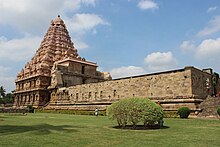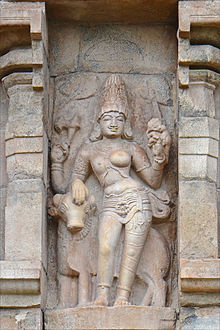Gangaikonda Cholapuram
This article needs additional citations for verification. (July 2013) |
Gaṅgaikoṇḍa Chōḻapuram | |
|---|---|
Town | |
| Gaṅgaikoṇda Chōḻapuram | |
UTC+5:30 (IST ) |
Gaṅgaikoṇḍa Chōḻapuram is a village located near to
The town is about approximately 125 kilometres (78 mi) northeast of Tiruchirapalli international airport. As of 2014, the ancient city exists as a heritage town in the Ariyalur district of Tamil Nadu, India. The great Arulmigu Peruvudaiyar Temple at this place is next only to the Arulmigu Peruvudaiyar Kovil at Thanjavur in its monumental nature and surpasses it in sculptural quality.[1] It has been recognised as a World Heritage site by UNESCO.[2]
Etymology
This section is empty. You can help by adding to it. (August 2023) |
History

The city was founded by
The city seems to have had two fortifications, one inner and the other outer. The outer was probably wider. The remains of the outer fortification can be seen as a mound running all around the palace.

Excavations suggest that the outer fortification was built of burnt bricks, was about six to eight feet wide. It consisted of two walls, the intervening space (the core) being filled with sand. The bricks are fairly large in size and are made of well-burnt clay.[3][4] The Tamil Nadu State Archaeological Department has taken up fresh excavations to probe a nearby village named Ayudhkalam which is believed to have weapon manufacturing workshops, as the name suggests.[5]
The surviving temple in Gangaikonda Cholapuram was completed in 1035 CE.
Rajendra I, according to Tamil tradition, thereafter assumed the name of Gangaikonda Cholan, meaning the one who conquered the Ganges. He established Gangaikonda Cholapuram as his capital from the medieval Chola capital of
The reasons for the city's destruction are unclear. According to Vansanthi, the
Arts and architecture
Chola rulers were patrons of the arts and architecture. They built the temple of Gangaikondacholisvara. The temple has sculptures of exceptional quality. The bronzes of Bhogasakti and Subrahmanya are masterpieces of Chola metal icons. The Saurapitha (Solar altar), the lotus altar with eight deities, is considered auspicious.[2] The shiva lingam is made from single rock.
The Chola rulers constructed enormous stone temple complexes with intricate carvings of Hindu gods. Rajaraja I built the famous Brihdrishvara temple at Thanjavur, which is about 50 km away from city of Gangaikonda Cholapuram, between 1003 and 1010 CE. Shiva is worshipped here. The grandeur of this temple has not been diminished by age. There is a massive statue of Nandi, the sacred bull of Shiva, in the central courtyard of the temple.
The exquisite bronze statues of the Chola period are known the world over for their grace and lifelike appearance. Many beautiful figures of Nataraja, or the dancing Shiva, were made during the Chola era.
Royal Palace

The royal palace also was built of burnt brick. The ceilings were covered with flat tiles of small size, laid in a number of courses, in fine lime mortar. The pillars were probably made of polished wood, supported on granite bases; a few pillar bases have survived to this day. Iron nails and clamps have been recovered from this palace site. There is a tunnel that links the palace and the temple inner 1st prakaara (north).

In the reign of

Roads and City gates

Besides the names of the palace and fort walls, the names of a few roads and streets are preserved in the epigraphs. The entryways named Thiruvasal, the eastern gate and the Vembugudi gate, evidently the south gate leading to the village Vembugudi situated in that direction are mentioned. Reference is also found to highways named after Rajaraja and Rajendra as Rajarajan Peruvali and Rajendran Peruvali. Other streets mentioned in epigraphs are the ten streets (Pattu teru), the gateway lane (Thiruvasal Narasam) and the Suddhamali lane. The inscription also refers to the highways, Kulottungacholan Thirumadil peruvali, Vilangudaiyan Peruvali and Kulaiyanai pona Peruvali (the highway through which a short elephant passed by).
City layout
The epigraphs also refer to the Madhurantaka Vadavaru, now called the Vadavaru, running about six kilometers east of the ruined capital. Madhurantaka Vedavaru, named after one of the titles of Rajendra I, was a source of irrigation to a vast stretch of land bordering the capital. An irrigation channel called Anaivettuvan is also mentioned.
"Anaivettuvan" - Anai means irrigation (step irrigation) vettuvan means labour or engineer.
There were both wet and dry lands inside the Fort, used for cultivation and other purposes. The present positions of the existing temples throw some light on the lay out of the city. With the palace as the centre to the city, the great temple, and the other temples in the city seem to have been erected. Towards the northeast (Isanya) of the palace is the great temple of Siva. The Siva temple according to
A number of small tanks and ponds mentioned in inscriptions and a number of wells, supplied drinking water to the residents.
See also
- Suryadeva Yajvan, a 12th-13th century scholar from Gangaikonda Cholapuram
Notes
- ^ Thanjavur was a target of both Muslim and Hindu neighboring kingdoms, both near and far. The Madurai Sultanate was established in the 14th century, after the disastrous invasions and plunder of South India by Ala ud-Din Khalji's armies of Delhi Sultanate led by Malik Kafur.[13] Later Adil Shahi Sultanate, Qutb Shahis, Randaula Khan and others from east and west coasts of South India raided it, and some occupied it for a few years.[12]
References
- ISSN 0047-8555.
- ^ a b "Great Living Chola Temples".
- ^ a b c d S.R. Balasubrahmanyam 1975, pp. 241–249.
- ^ ISBN 978-981-230-938-9.
- ^ "Iron nails, earthen tiles found at Ariyalur site | Trichy News - Times of India". The Times of India. TNN. 20 March 2021. Retrieved 29 March 2021.
- ISBN 9780231515245.
- ISBN 9781610690263.
- ^ Pillai, J.M. Somanasundaram (1994). The great temple at Tanjore. Tamil University, Thanjavur. pp. 109–111.
- ^ ISBN 978-0-7864-9033-2.
- ^ George Michell (1986). Islamic heritage of the Deccan. Mārg Publications. p. 8.
- ISBN 978-90-04-16859-6.
- ^ a b c George Michell (2008), Architecture and art of Southern India, Cambridge University Press, pages 16-21, 89-91
- ^ George Michell (2008), Architecture and art of Southern India, Cambridge University Press, pages 9-13, 16-21
- ^ Balaganessin, M. (31 January 2017). "Gangaikondacholapuram temple to be consecrated". The Hindu.
- ^ "Gangaikonda Cholapuram Temple Kumbabishekam | கங்கைகொண்ட சோழபுரத்தில் கும்பாபிஷேகம் கோலாகலம்!" (in Tamil).
Bibliography
- S.R. Balasubrahmanyam (1975), Middle Chola Temples, Thomson Press, ISBN 978-9060236079
- Michell, George (1988), The Hindu Temple: An Introduction to Its Meaning and Forms, Chicago: University of Chicago Press, ISBN 0-226-53230-5
- Nagasamy R, Rajapalayam (1970), State Department of Archaeology, Government of Tamil Nadu
- Nilakanta Sastri, K. A., The Cholas (1955), University of Madras, Reprinted 1984
External links
- Maligai Medu – Buried in Time
